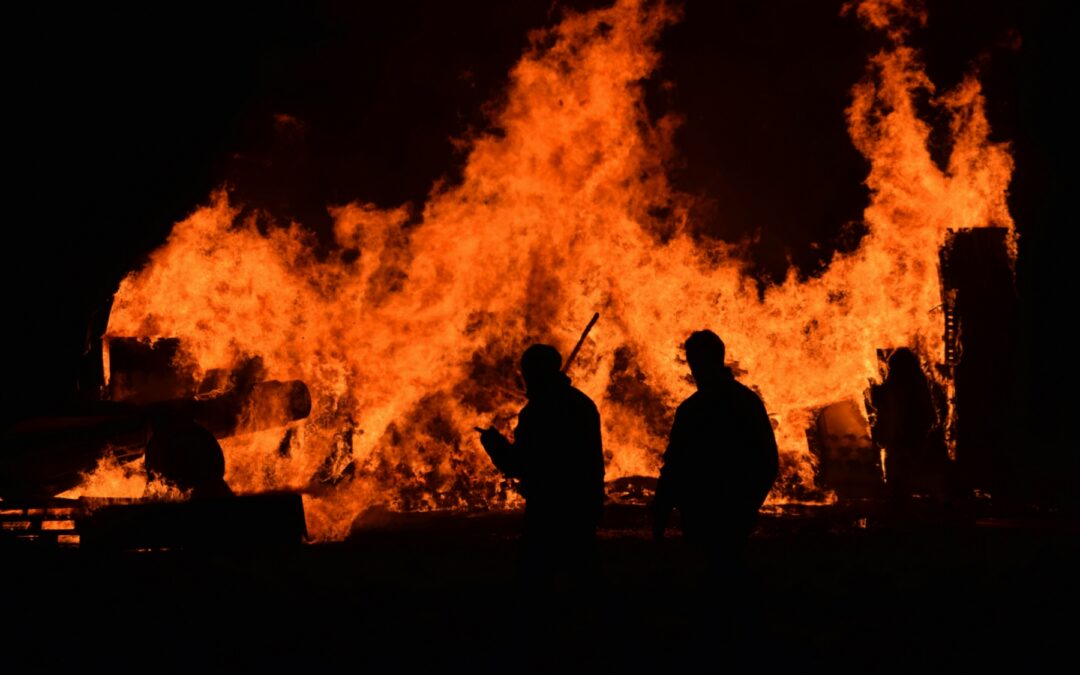
by Robyn Bolton | Aug 11, 2025 | AI
“We have to do more with less” has become an inescapable mantra, and goodness, are you trying. You’ve slashed projects and budgets, “right-sized” teams, and tried any technology that promised efficiency and a free trial. Now, all that’s left is to replace the people you still have with AI creativity tools. Welcome to the era of the AI Innovation Team.
It sounds like a great idea. Now, everyone can be an innovator with access to an LLM. Heck, even innovation firms are “outsourcing” their traditional work to AI, promising the same radical results with less time and for far less money.
It sounds almost too good to be true.
Because it is too good to be true.
AI is eliminating the very brain processes that produce breakthrough innovations.
This isn’t hyperbole, and it’s not just one study.
MIT researchers split 54 people into three groups (ChatGPT users, search engine users, and no online/AI tools using ChatGPT) and asked them to write a series of essays. Using EEG brain monitoring, they found that the brain connectivity in networks crucial for creativity and analogous thinking dropped by 55%.
Even worse? When people stopped using AI, their brains stayed stuck in this diminished state.
University of Arkansas researchers tested AI against 3,562 humans on a series of four challenges involving finding new uses for everyday objects, like a brick or paperclip. While AI scored slightly higher on standard tests, when researchers introduced a new context, constraint, or modification to the object, AI’s performance “collapsed.” Humans stayed strong.
Why? AI relies on pattern matching and is unable to transfer its “creativity” to unexpected scenarios. Humans use analogical reasoning so are able to flex quickly and adapt.
University of Strasbourg researchers analyzed 15,000 studies of COVID-19 infections and found that teams that relied heavily on AI experts produced research that got fewer citations and less media attention. However, papers that drew from diverse knowledge sources across multiple fields became widely cited and influential.
The lesson? Breakthroughs require cross-domain thinking, which is precisely what diverse human teams provide, and, according to the MIT study, AI is unable to produce.
How to optimize for efficiency AND impact (and beat your competition)
While this seems like bad news if you’ve already cut your innovation team, the silver lining is that your competition is probably making the same mistake.
Now that you know better, you can do better, and that creates a massive opportunity.
Use AI for what it does well:
- Data analysis and synthesis
- Rapid testing and iteration to refine an advanced prototype
- Process optimization
Use humans for what we do well:
- Make meaningful connections across unrelated domains
- Recognize when discoveries from one field apply to another
- Generate the “aha moments” that redefine industries
Three Questions to Ask This Week
- Where did your most recent breakthroughs come from? How many came from connecting insights across different domains? If most of your innovations require analogical leaps, cutting creative teams could kill your pipeline.
- How are teams currently using AI tools? Are they using AI for data synthesis and rapid iteration? Good. Are they replacing human ideation entirely? Problem.
- How can you see it to believe it? Run a simple experiment: Give two teams an hour to solve a breakthrough challenge. Have one solve it with AI assistance and one without. Which solution is more surprising and potentially breakthrough?
The Hidden Competitive Advantage
As AI commoditizes pattern recognition, human analogical thinking and creativity become a competitive advantage.
The companies that figure out the right balance will eat everyone else’s lunch.

by Robyn Bolton | Aug 4, 2025 | Leadership, Leading Through Uncertainty, Stories & Examples, Strategy
The best business advice can destroy your business. Especially when you follow it perfectly.
Just ask Johnny Cash.
After bursting onto the scene in the mid-1950s with “Folsom Prison Blues”, Cash enjoyed twenty years of tremendous success. By the 1970s, his authentic, minimalist approach had fallen out of favor.
Eager to sell records, he pivoted to songs backed by lush string arrangements, then to “country pop” to attract mainstream audiences and feed the relentless appetite of 900 radio stations programming country pop full-time.
By late 1992, Johnny Cash’s career was roadkill. Country radio had stopped playing his records, and Columbia Records, his home for 25 years, had shown him the door. At 60, he was marooned in faded casinos, playing to crowds preferring slot machines to songs.
Then he took the stage at Madison Square Garden for Bob Dylan’s 30th anniversary concert.
In the audience sat Rick Rubin, co-founder of Def Jam Recordings and uber producer behind Public Enemy, Run-DMC, and Slayer, amongst others. He watched in awe as Cash performed, seeing not a relic but raw power diluted by smart decisions.
The Stare-Down that Saved a Career
Four months later, Rubin attended Cash’s concert at The Rhythm Café in Santa Anna, California. According to Cash’s son, “When they sat down at the table, they said: ‘Hello.’ But then my dad and Rick just sat there and stared at each other for about two minutes without saying anything, as if they were sizing each other up.”
Eventually, Cash broke the silence, “What’re you gonna do with me that nobody else has done to sell records for me?”
What happened next resurrected his career.
Rubin didn’t promise record sales. He promised something more valuable: creative control and a return to Cash’s roots.
Ten years later, Cash had a Grammy, his first gold record in thirty years, and CMA Single of the Year for his cover of Nine Inch Nails’ “Hurt,” and millions in record sales.
When Smart Decisions Become Fatal
Executives do exactly what Cash did. You respond to market signals. You pivot your offering when customer preferences shift and invest in emerging technologies.
All logical. All defensible to your board. All potentially fatal.
Because you risk losing what made you unique and valuable. Just as Cash lost his minimalist authenticity and became a casualty of his effort to stay relevant, your business risks losing sight of its purpose and unique value proposition.
Three Beliefs at the Core of a Comeback
So how do you avoid Cash’s initial mistake while replicating his comeback? The difference lies in three beliefs that determine whether you’ll have the creative courage to double down on what makes you valuable instead of diluting it.
- Creative confidence: The belief we can think and act creatively in this moment.
- Perceived value of creativity: Our perceived value of thinking and acting in new ways.
- Creative risk-taking: The willingness to take the risks necessary for active change.
Cash wanted to sell records, and he:
- Believed that he was capable of creativity and change.
- Saw the financial and reputational value of change
- Was willing to partner with a producer who refused to guarantee record sales but promised creative control and a return to his roots.
Your Answers Determine Your Outcome
Like Cash, what you, your team, and your organization believe determines how you respond to change:
- Do I/we believe we can creatively solve this specific challenge we’re facing right now?
- Is finding a genuinely new approach to this situation worth the effort versus sticking with proven methods?
- Am I/we willing to accept the risks of pursuing a creative solution to our current challenge?”
Where there are “no’s,” there is resistance, even refusal, to change. Acknowledge it. Address it. Do the hard work of turning the No into a Yes because it’s the only way change will happen.
The Comeback Question
Cash proved that authentic change—not frantic pivoting—resurrects careers and disrupts industries. His partnership with Rubin succeeded because he answered “yes” to all three creative beliefs when it mattered most. Where are your “no’s” blocking your comeback?

by Robyn Bolton | Jul 29, 2025 | Podcasts

by Robyn Bolton | Jul 28, 2025 | 5 Questions, Leadership
Picture this: your boss announces a major reorganization with a big smile, expecting you to be excited about “new opportunities.” Meanwhile, you’re sitting there thinking “What the hell just happened to my job?”
Theresa Ward, founder and Chief Momentum Officer of Fiery Feather, has spent years watching this disconnect play out. Her insight? Leaders are expected to sell change while still personally struggling with it, creating what she calls “that weird middle ground” where authenticity goes to die.
Our conversation revealed why unwelcome change triggers the same response as grief, and why leaders who stop pretending they’ve got it figured out are more successful.
Robyn Bolton: What’s the one piece of conventional wisdom about leading change that organizations need to unlearn?
Theresa Ward: That middle managers need to be enthusiastic about a change, or at least appear enthusiastic, to lead their teams through it.
RB: It seems like enthusiasm is important to get people on board and doing what they need to do to make change happen. Why is this wrong?
TW: Because it makes you wonder if this person is being authentic. Are they genuinely enthusiastic? Do they really believe this is the right thing?
To be clear, I’m talking about Unwelcome Change. Change that is thrust upon you. How we experience Unwelcome Change is the same way we experience grief.
When we initially experience Unwelcome Change, our brain goes into shock or denial which can actually trigger an increase in engagement and productivity.
Then we move into anger and blame, which looks different for all of us. We’ve probably experienced somebody yelling in a meeting, but it can also look like turning off the camera, folding your arms, rolling your eyes, and disengaging.
Bargaining. I always think of that clip from Jerry Maguire, where he’s got the goldfish, and he says, “Who’s coming with me?” because he’s going to make lemonades out of this lemon, even if it’s a completely ridiculous condition.
Then depression sets in. It’s the low point but it’s also where you’re really ready to admit that you’re upset, sad, and grieving the change that has happened. It’s the dark before the dawn.
RB: If everyone goes through this grief process, why do some leaders seem genuinely enthusiastic about the change?”
TW: If they came up with the idea, they’re not going to be angry or depressed about their own idea.
But even if it’s one announcement, people don’t experience just one change. It’s not, “Our budget is going from X to Y” and everyone can just get used to it. It’s double or triple that! It’s a budget cut, then a reorg, then a new boss, then a friend being laid off, then a project you loved getting trashed. You’re dealing with onion layers of change.
We all go through different stages at speeds. You can’t rush it. Sometimes you just have to be like, “Oh, okay, I’m feeling pretty angry this week. I’m just gonna have to sit through my anger phase and realize that it’s a phase.”
RB: I get that you can’t rush the process, but change doesn’t slow down so you can catch up. What can people do to navigate change while they’re processing it?
TW: BLT, baby. These are 3 tools, not a formula, that you can use for different experiences.
B stands for Benefit of Change. This is finding the silver lining, something we often underestimate because it’s such a broad cliche. For it to be effective, you need to look for a specific and personal silver lining. For example, a friend of mine works for a company that was acquired. He was not a fan of how the culture was changing, but the bigger company offered tuition reimbursement. So he used that to get his master’s of fine arts for free.
L is Locus of Control. Take inventory of everything that’s upsetting you and place it into one of 3 categories: What can I control? What can I influence? What do I need to just surrender? Sitting up at night and worrying about whether the budget will be cut again is outside of my control. So, I shouldn’t spend my time and energy on that. Instead, I need to focus on what I can control, like my attitude and response.
T is Take the Long View. Every day we find ourselves in situations that get us emotional – a traffic jam, getting cut off in traffic, or flubbing a big client presentation. When we get more emotional than what the situation calls for, ask how you’re going to feel about the situation tomorrow, then in a month, then a year Because when our fight or flight brain mode kicks in, we catastrophize things. But the reality is that most of it won’t matter tomorrow.
RB: What’s the most important mindset shift leaders need to make to help their teams through unwelcome change?
TW: Find what works for you first then, with empathy, help your team. Like the Airline Safety Video, put your mask on first, then help others. It allows you to be authentic and builds empathy with the team. Two things required to start the shift from unwelcome to accepted.
Theresa’s BLT framework won’t make change painless, but it gives you permission to admit that transformation is hard, even for leaders. The moment you stop pretending you’ve got it all figured out is the moment your team starts trusting you to guide them through the mess.

by Robyn Bolton | Jul 23, 2025 | Leadership, Leading Through Uncertainty, Stories & Examples
What does a lightning strike in a Spanish forest have to do with your next leadership meeting? More than you think.
On June 14, 2014, lightning struck a forest on Spain’s northeast coast, only 60 miles from Barcelona. Within hours, flames 16 to 33 feet high raced out of control toward populated areas, threatening 27,000 acres of forest, an area larger than the city of Boston.
Everything – data, instincts, decades of firefighting doctrine – prioritized saving the entire forest and protecting the coastal towns.
Instead, the fire commanders chose to deliberately let 2,057 acres, roughly the size of Manhattan’s Central Park, burn.
The result? They saved the other 25,000 acres (an area the size of San Francisco), protected the coastal communities, and created a natural firebreak that would protect the region for decades. By accepting some losses, they prevented catastrophic ones.
The Fear Trap That’s Strangling Your Business
The Tivissa fire’s triumph happened because firefighters found the courage to escape what researchers call the “fear trap” – the tendency to focus exclusively on defending against known, measurable risks.
Despite research proving that defending against predictable, measurable risks through defensive strategies consistently fails in uncertain and dynamic scenarios, firefighter “best practices” continue to advocate this approach.
Sound familiar? It should. Most executives today are trapped in exactly this pattern.
We’re in the fire right now. Financial markets are yo-yoing, AI threatens to disrupt everything, and consumer behaviors are shifting.
Most executives are falling into the Fear Trap by doubling down on protecting their existing business and pouring resources into defending against predictable risks. Yet the real threats, the ones you can’t measure or model, continue to pound the business.
While you’re protecting last quarter’s wins, tomorrow’s disruption is spreading unchecked.
Four Principles for Creative Decision-Making Under Fire
The decision to cede certain areas wasn’t hasty but based on four principles enabling leaders in any situation to successfully navigate uncertainty.
PRINCIPLE 1: A Predictable Situation is a Safe Situation. Stop trying to control the uncontrollable. Standard procedures work in predictable situations but fail in unprecedented challenges.
Put it in Practice: Instead of creating endless contingency plans, build flexibility and agility into operations and decision-making.
PRINCIPLE 2: Build Credibility Through Realistic Expectations. Reducing uncertainty requires realism about what can be achieved. Fire commanders mapped out precisely which areas around Tivissa would burn and which would be saved, then communicated these hard truths and the considered trade-offs to officials and communities before implementing their strategy, building trust and preventing panic as the selected areas burned.
Put it in practice: Stop promising to protect everything and set realistic expectations about what you can control. Then communicate priorities, expectations, and trade-offs frequently, transparently, and clearly with all key stakeholders.
PRINCIPLE 3: Include the future in your definition of success: Traditional firefighting protects immediate assets at risk. The Tivissa firefighters expanded this to include future resilience, recognizing that saving everything today could jeopardize the region tomorrow.
Put it in practice: Be transparent about how you define the Common Good in your organization, then reinforce it by making hard choices about where to compete and where to retreat. The goal isn’t to avoid all losses – it’s to maximize overall organizational health.
PRINCIPLE 4: Use uncertainty to build for tomorrow: Firefighters didn’t just accept that 2,057 acres would burn – they strategically chose which acres to let burn to create maximum future advantage, protecting the region for generations.
Put it in practice: Evaluate every response to uncertainty on whether it better positions you for future challenges. Leverage the disruption to build capabilities, market positions, and organizational structures that strengthen you for future uncertainty.
Your Next Move
When the wind shifted and the fire exploded, firefighters had to choose between defending everything (and likely losing it all) or accepting strategic losses to ensure overall wins.
You’re facing the same choice right now.
Like the firefighters, your breakthrough might come not from fighting harder against uncertainty, but from learning to work with it strategically.
What are you willing to let burn to save what matters most?




